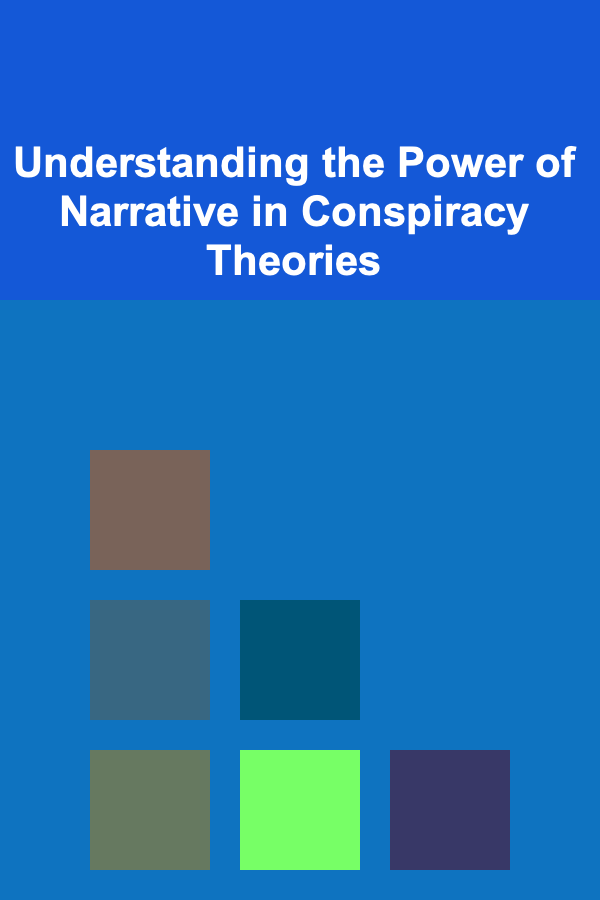
Understanding the Power of Narrative in Conspiracy Theories
ebook include PDF & Audio bundle (Micro Guide)
$12.99$10.99
Limited Time Offer! Order within the next:

Conspiracy theories, often dismissed as fringe beliefs, hold a significant sway over a substantial portion of the population. While various factors contribute to their allure, the power of narrative stands out as a critical, often overlooked, element. These narratives are not simply collections of claims; they are carefully constructed stories that offer explanations, assign blame, and provide a sense of purpose or belonging. Understanding how these narratives function is crucial to comprehending the appeal of conspiracy theories and developing effective strategies to address them.
The Building Blocks of Conspiracy Narratives
Conspiracy narratives share several common characteristics that contribute to their persuasive power:
1. Coherence and Simplicity: The Appeal of a Unified Explanation
In a complex and often chaotic world, conspiracy theories offer a deceptively simple and coherent explanation for events. They connect seemingly disparate events into a single, overarching narrative, often attributing them to the actions of a hidden cabal. This simplification, while inaccurate, provides a sense of order and control. For example, a complex geopolitical conflict might be explained as the deliberate manipulation of a single entity seeking global domination. The messiness of historical contingencies, economic factors, and individual motivations is conveniently swept away, replaced with a clear, albeit unfounded, causal chain. This coherence is especially attractive when official explanations are perceived as inadequate, incomplete, or deliberately misleading. The human brain is wired to seek patterns and meaning, and conspiracy narratives readily provide both, even if those patterns are illusory.
2. The Villain and the Hero: A Morality Play
Conspiracy narratives typically feature clearly defined villains and, implicitly or explicitly, heroes. The villains are often powerful and malevolent figures or groups, such as governments, corporations, secret societies, or specific ethnic or religious groups. They are depicted as actively working to undermine the well-being of ordinary people. This villain provides a target for anger and frustration. The "hero," in contrast, is often the conspiracy theorist themselves, or the group they are trying to awaken. They are portrayed as courageous truth-seekers battling against overwhelming odds. This creates a sense of purpose and moral righteousness. The narrative transforms the believer into a participant in a grand struggle between good and evil. The individual is no longer a passive observer but an active agent in uncovering and fighting against the supposed conspiracy.
3. Secret Knowledge and Exclusivity: The Allure of Being "In the Know"
A key element of conspiracy narratives is the idea that the truth is hidden from the general public, deliberately suppressed by the powerful entities behind the conspiracy. Believers feel they possess secret knowledge, a privileged insight into the "real" workings of the world. This sense of exclusivity creates a powerful feeling of belonging and intellectual superiority. They are "awake" while others remain "asleep." This exclusivity is often reinforced through coded language, insider terminology, and the sharing of "evidence" that is inaccessible to the mainstream. This creates a sense of community and reinforces the believer's conviction that they are part of a select group who understand the truth. The more esoteric and difficult to understand the "evidence," the more valuable it becomes within the conspiracy theory community, solidifying the belief system.
4. Suspicion and Distrust: Questioning Authority
Conspiracy narratives thrive on a climate of suspicion and distrust, particularly towards established institutions and authority figures. They encourage individuals to question everything, to challenge official narratives, and to see hidden motives behind every action. This distrust can be fueled by genuine instances of government misconduct, corporate corruption, or media bias. However, conspiracy narratives often amplify and distort these legitimate concerns, creating a generalized skepticism that is resistant to reason and evidence. The mantra "do your own research" is often used to justify the rejection of expert opinion and the acceptance of unsubstantiated claims. This creates a self-reinforcing cycle of distrust, where any evidence that contradicts the conspiracy theory is dismissed as part of the cover-up.
5. Emotional Resonance: Fear, Anger, and Hope
Conspiracy narratives are rarely purely intellectual exercises. They often tap into deep-seated emotions, such as fear, anger, anxiety, and even hope. Fear of the unknown, of losing control, or of being harmed by unseen forces is a powerful motivator. Anger towards those perceived to be responsible for societal problems can also fuel belief in conspiracy theories. However, conspiracy narratives can also offer a sense of hope. The belief that the truth can be uncovered and that the villains can be defeated can be empowering, especially for individuals who feel marginalized or disempowered. The promise of a better future, free from the control of the conspirators, can be a powerful draw. This emotional connection is crucial to the narrative's staying power. It allows the conspiracy theory to bypass critical thinking and appeal directly to the individual's emotional state.
How Conspiracy Narratives Are Constructed and Maintained
The construction and maintenance of conspiracy narratives is a dynamic process involving several key mechanisms:
1. Cherry-Picking and Confirmation Bias: Selective Evidence
Conspiracy theorists often engage in cherry-picking, selectively choosing evidence that supports their pre-existing beliefs while ignoring or dismissing evidence that contradicts them. This confirmation bias is a common cognitive bias that affects everyone, but it is particularly pronounced in the context of conspiracy theories. Any piece of information, no matter how tenuous or circumstantial, can be interpreted as evidence of the conspiracy, while contradictory evidence is dismissed as disinformation or part of the cover-up. This creates a closed loop of reasoning where the conspiracy theory is constantly reinforced, regardless of the available evidence. The more evidence that contradicts the theory, the stronger the belief in the conspiracy becomes, as the contradictory evidence is seen as further proof of the conspiracy's power and reach.
2. The "Just Asking Questions" Technique: Sowing Doubt
Conspiracy theorists often employ the tactic of "just asking questions" to sow doubt about established facts and undermine the credibility of experts. This technique involves posing questions that are seemingly innocuous but are actually designed to insinuate that something is amiss. For example, instead of directly claiming that a particular event was a false flag operation, a conspiracy theorist might ask, "Isn't it strange that...?" or "Doesn't it seem odd that...?" This allows them to introduce doubt without making explicit claims that can be easily refuted. This strategy exploits the human tendency to seek answers and to fill in gaps in information. By raising questions without providing definitive answers, conspiracy theorists encourage others to engage in their own "research," which often leads them down the rabbit hole of conspiracy thinking.
3. Analogies and Metaphors: Creating Meaningful Connections
Conspiracy narratives often rely on analogies and metaphors to make complex ideas more accessible and to create emotional connections with the audience. For example, the idea of a "deep state" is often used to describe a shadowy network of unelected officials who are supposedly controlling the government from behind the scenes. This metaphor conjures up images of hidden power and manipulation, making it easier for people to understand and accept the idea that something sinister is going on. Similarly, metaphors of "awakening" and "red-pilling" are used to describe the process of becoming aware of the "truth" about the conspiracy. These metaphors create a sense of urgency and importance, encouraging people to take action and share their newfound knowledge with others. Analogies can also be used to draw parallels between seemingly unrelated events, suggesting that they are all part of the same grand conspiracy.
4. Community Building and Social Reinforcement: The Power of Shared Belief
Conspiracy theories are often spread and reinforced within online communities and social networks. These communities provide a safe space for believers to share their ideas, find validation, and support each other. The constant exposure to like-minded individuals reinforces their beliefs and makes them more resistant to outside criticism. Within these communities, conspiracy narratives are constantly being refined, updated, and expanded, creating a dynamic and evolving belief system. Social media algorithms can also contribute to this phenomenon by creating echo chambers where individuals are primarily exposed to information that confirms their existing beliefs. This can lead to a radicalization effect, where individuals become increasingly isolated from mainstream perspectives and more deeply entrenched in their conspiracy beliefs.
5. Exploitation of Uncertainty and Ambiguity: Filling the Void
Conspiracy narratives thrive in situations of uncertainty and ambiguity. When there is a lack of clear information about an event or situation, people are more likely to turn to conspiracy theories as a way to make sense of what is happening. This is particularly true in the aftermath of traumatic events, such as natural disasters, terrorist attacks, or political assassinations. Conspiracy theories offer a clear and concise explanation for these events, even if that explanation is based on speculation and conjecture. They fill the void of uncertainty with a readily available narrative, providing comfort and reassurance in a time of chaos and confusion. The more unclear or contradictory the official explanations, the more appealing the conspiracy theory becomes.
The Psychological and Social Functions of Conspiracy Narratives
Understanding the psychological and social functions that conspiracy narratives serve is essential to addressing their appeal:
1. Epistemic Needs: The Desire for Knowledge and Understanding
Humans have a fundamental need to understand the world around them and to make sense of complex events. Conspiracy theories offer a framework for understanding, providing answers to questions that might otherwise remain unanswered. They offer a sense of cognitive closure, reducing uncertainty and ambiguity. Even if the explanations are flawed or inaccurate, they provide a sense of order and predictability in a chaotic world. This can be particularly appealing to individuals who feel overwhelmed by the complexity and uncertainty of modern life. The belief that one understands the "real" reasons behind events, even if those reasons are conspiratorial, can be psychologically comforting.
2. Existential Needs: The Desire for Safety and Control
Conspiracy theories can also address existential needs, such as the desire for safety and control. By identifying a clear enemy or threat, they provide a target for fear and anger, allowing individuals to feel like they are taking action to protect themselves and their loved ones. The belief that one can uncover and expose the conspiracy can also create a sense of agency and control in a world that often feels unpredictable and overwhelming. Even if the conspiracy is vast and powerful, the act of believing in and fighting against it can be empowering. This is particularly true for individuals who feel marginalized or disempowered by traditional power structures.
3. Social Needs: The Desire for Belonging and Connection
Conspiracy theories can fulfill social needs by providing a sense of belonging and connection to a community of like-minded individuals. These communities offer a safe space for believers to share their ideas, find validation, and support each other. The shared belief in the conspiracy creates a strong sense of group identity and purpose. This can be particularly appealing to individuals who feel isolated or disconnected from mainstream society. The feeling of being "in the know" and part of a select group can be a powerful motivator for maintaining belief in the conspiracy.
Addressing the Power of Narrative in Conspiracy Theories
Addressing the power of narrative in conspiracy theories requires a multi-faceted approach that goes beyond simply debunking specific claims:
1. Understanding the Underlying Needs: Empathy and Active Listening
Instead of simply dismissing conspiracy theorists as irrational or delusional, it is important to understand the underlying needs that their beliefs are fulfilling. Empathy and active listening can be valuable tools for building trust and understanding their perspective. By acknowledging their concerns and showing that you are taking them seriously, you can create an environment where they are more open to considering alternative viewpoints. Avoid condescending or dismissive language, and focus on understanding their motivations and concerns. Ask open-ended questions and listen carefully to their responses. This can help you identify the specific needs that the conspiracy theory is fulfilling for them and tailor your response accordingly.
2. Counter-Narratives: Offering Alternative Explanations
Instead of simply debunking conspiracy claims, it can be more effective to offer alternative narratives that provide a more accurate and nuanced understanding of the events in question. These counter-narratives should be grounded in evidence and logic, but they should also be emotionally compelling and relatable. They should address the same needs that the conspiracy narrative is fulfilling, such as the need for understanding, safety, and belonging. This requires careful research and attention to detail, as well as the ability to communicate complex information in a clear and engaging way. These narratives should also acknowledge the uncertainty and ambiguity that often surrounds complex events, rather than offering simplistic and overly confident explanations.
3. Promoting Critical Thinking Skills: Empowering Individuals
Promoting critical thinking skills is essential for empowering individuals to evaluate information and resist the allure of conspiracy theories. This includes teaching people how to identify cognitive biases, evaluate sources, and distinguish between correlation and causation. It also involves encouraging them to question their own assumptions and to be open to considering alternative perspectives. Critical thinking skills can be taught in schools, community centers, and online, and they should be emphasized throughout the lifespan. These skills are not just important for resisting conspiracy theories, but also for navigating the complex and ever-changing information landscape of the 21st century.
4. Building Trust in Institutions: Transparency and Accountability
Rebuilding trust in institutions is crucial for undermining the appeal of conspiracy theories. This requires greater transparency and accountability from governments, corporations, and media organizations. When institutions are perceived as being opaque or corrupt, people are more likely to turn to conspiracy theories as a way to explain their actions. Transparency can be achieved through open data initiatives, public forums, and whistleblower protection laws. Accountability requires holding individuals and organizations responsible for their actions, and ensuring that there are consequences for wrongdoing. This can help to restore public trust and reduce the appeal of conspiracy narratives that thrive on distrust.
5. Combating Misinformation Online: Algorithmic Transparency and Fact-Checking
Combating the spread of misinformation online is essential for preventing the radicalization of individuals and the proliferation of conspiracy theories. This requires collaboration between social media companies, fact-checkers, and researchers to identify and remove false or misleading content. It also requires greater algorithmic transparency, so that users can understand how information is being filtered and prioritized. Social media companies should also invest in educating users about misinformation and providing them with tools to identify and report it. Fact-checking organizations play a crucial role in debunking false claims and providing accurate information to the public. However, fact-checking alone is not enough; it must be combined with efforts to promote critical thinking skills and build trust in credible sources of information.
Conclusion
The power of narrative is a critical factor in understanding the appeal and persistence of conspiracy theories. By understanding how these narratives are constructed, maintained, and what needs they fulfill, we can develop more effective strategies to address them. This requires a multi-faceted approach that combines empathy, critical thinking, counter-narratives, and efforts to rebuild trust in institutions. Ultimately, the goal is not simply to debunk specific conspiracy claims, but to empower individuals to critically evaluate information, resist the allure of simplistic explanations, and engage in informed and constructive dialogue about the complex challenges facing our world. By recognizing and addressing the underlying psychological and social factors that contribute to belief in conspiracy theories, we can create a more resilient and informed society.
Reading More From Our Other Websites
- [Weaving Tip 101] How to Transform Old Wallpaper into Vibrant Weave Panels for Eco‑Conscious Interiors
- [Screen Printing Tip 101] Choosing the Right Ink and Mesh: A Beginner's Cheat Sheet
- [Home Storage Solution 101] How to Use Under-Bed Storage Effectively
- [Personal Care Tips 101] How to Combine Facial Cleanser with Face Oils for a Nourishing Skincare Routine
- [Home Pet Care 101] How to Stop Your Pet from Begging at the Table
- [Personal Care Tips 101] How to Use Teeth Whitening Strips to Improve Your Smile for Special Events
- [Home Soundproofing 101] How to Soundproof Your Home While Keeping It Stylish
- [Home Maintenance 101] How to Clean and Maintain Your Home's Air Ducts for Better Indoor Air Quality
- [Home Family Activity 101] How to Build a Family Reading Routine at Home
- [Skydiving Tip 101] Maintenance Tips: Keeping Your Skydiving Canopy in Peak Condition

How to Maximize Closet Space with Creative Storage Solutions
Read More
How To Observe the Surface of Mars (Telescopic)
Read More
How To Explore the Expressive Power of the Saxophone in Jazz
Read More
Researching the Social Acceptance of Electric Vehicles: A Deep Dive
Read More
How to Navigate Difficult Patient Interactions: A PTA Perspective
Read More
How to Create a Self-Care To-Do List for Busy Entrepreneurs
Read MoreOther Products

How to Maximize Closet Space with Creative Storage Solutions
Read More
How To Observe the Surface of Mars (Telescopic)
Read More
How To Explore the Expressive Power of the Saxophone in Jazz
Read More
Researching the Social Acceptance of Electric Vehicles: A Deep Dive
Read More
How to Navigate Difficult Patient Interactions: A PTA Perspective
Read More